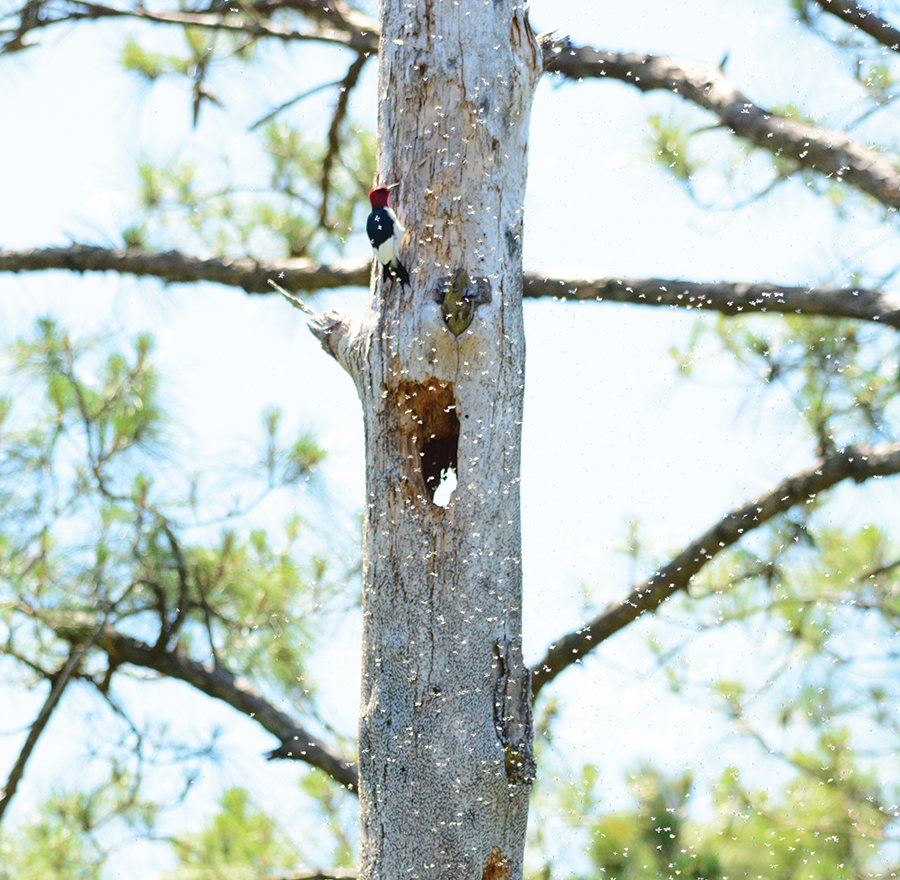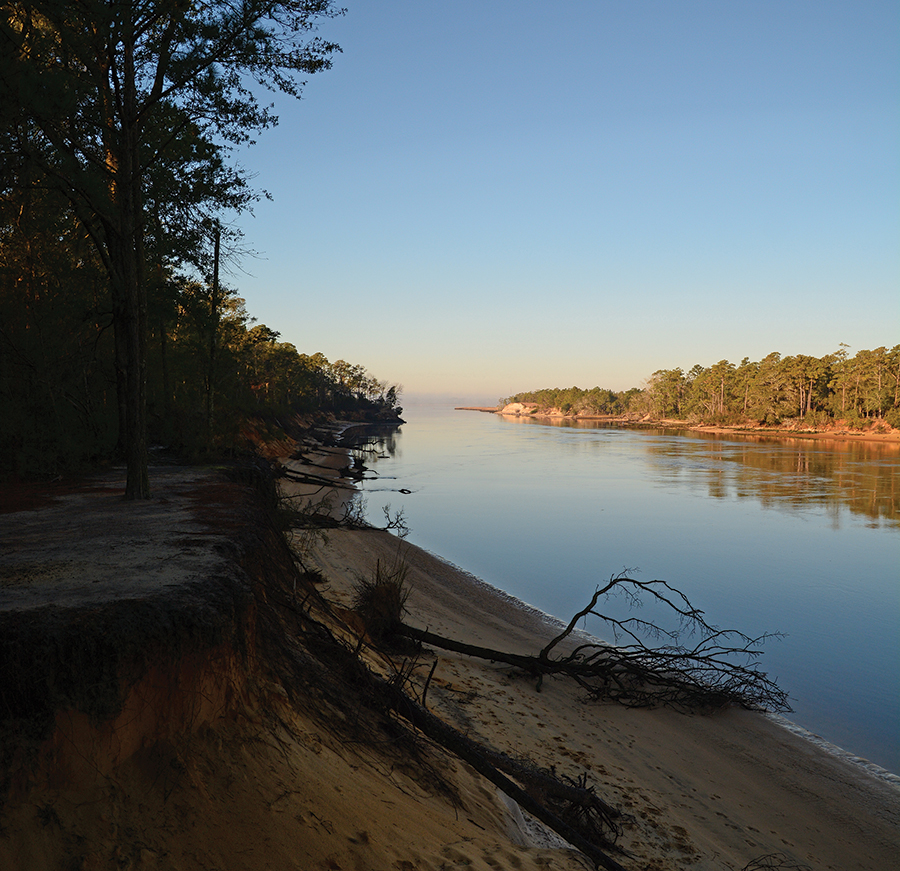Nothing is more inspiring in early spring than a nature walk
Story and Photographs by Virginia Holman
When we moved to the Cape Fear region some 15 years ago, one of the things I mourned publicly was the loss of the four distinct storybook seasons I had enjoyed in the Piedmont. I emailed an old friend during my first full year here in which I described a skillet-hot summer punctuated by fumes of fresh asphalt and diesel, followed by the cloudy-rainy-not-exactly-cool season that led to the cold-cloudy-early-sunset season (which to be fair, was also endured at my previous home). This led me to comment on the two spring days I enjoyed the most: the day in early May when I could wear my favorite white pointelle sweater outside without being too warm or too cold, and the day honeysuckle blooms and fills the air with its sweet scent. After that, the heat (and with it the din of air conditioners) arrived.
I may have exaggerated to my friend. Like many transplants, I was homesick and moody and on a perpetual diet because I thought living at the beach meant I was expected to wear a swimsuit three “seasons” a year. I was exasperated that living in Zone 8 meant I’d accidentally tossed out an expensive lot of tulip bulbs that I was told had to hibernate all winter in my freezer, not in the ground, or they would refuse to bloom. I missed the tender nodding hellebores I used to plant along the shaded edge of our Piedmont lot. In other words, the Cape Fear region wasn’t love at first sight, and I felt guilty about that — didn’t everyone want to live at the beach? Oddly enough, guilt didn’t ease my self-imposed suffering one whit; it was just a prism that refracted the past and kept me from moving forward in my new life.
Slowly, I gave up the guilt, and counterintuitively what went with it was habitual longing for the life I’d left behind. As year after year in my new home passed, I found that the coastal plain had more life and complexity than I had first realized. So, if you are a transplant yearning for signs of spring but don’t know where to look, here are a couple of places you can venture to walk quietly and look closely. If you visit these areas regularly, you can observe the slow, subtle shift of winter to spring, a sacred time of awakening, migration and regeneration that even a long season of storms can’t contain or destroy.
Perhaps the most pleasant spring hike you may take is to little-visited Ev-Henwood, a conservation area located in a still rural area of Leland, North Carolina. The name is pronounced exactly the same as performer and North Carolina native Evan Rachel Wood — if you omit the middle name and elide the first and last names. Local folks also like say it rhymes with Heavenwood, which is apt, since this protected land is a nature lover’s paradise. The 174-acre protected area is open from sunrise to sunset, and its trails meander through several important areas, including a preserved area that is used to teach students at UNCW about longleaf pine savannas and the process known as old field succession. Several trails run through the property; in addition, there is a remote, quiet bottomland trail that winds alongside Town Creek. The conservation area is owned and managed by UNC Wilmington and nearly 65 acres of the property that runs along Town Creek is protected by the Coastal Land Trust.

Unlike a state park, Ev-Henwood is not heavily maintained, but as an educational conservation site, it is well monitored. Among the list of rules and regulations is this note: “Observe your pathway carefully. No management of dangerous animals or poisonous plants is in effect on the property.” In other words, if you rest your hand on a tree beside the trail that happens to be covered in poison ivy, you’ll itch, and if you see an alligator swimming in a pond, don’t be too surprised.
This devotion to maintaining the area’s wildness makes Ev-Henwood a uniquely appealing site. Unlike a state park, most trails are narrow and lightly marked, with informational signage that only adds to the pleasantness of the experience. If you visit in early spring, take the Beechnut Trail. You’ll notice that as you walk past the parking area, man-made noises quickly give way to the rustle of the wind through the bare branches. This is my favorite time to stroll the area. The biting bugs are down, and because the upland trees have yet to leaf, it’s easier to see some of the interesting birds in the area. Birders who visit the area in the spring report many notable sightings, so take your binoculars. As you move from upland areas to bottomland swamp, you may get looks at yellow-billed cuckoos, red-eyed vireos, ovenbirds and summer tanagers, and as you approach the bottomland, you may get nice looks at resplendent yellow prothonotary warblers and vivid indigo buntings. These songbirds not only have fine plumage, but they also grace the forest with songs that are uncommonly beautiful. Visitors who take this trail will be rewarded when they reach Town Creek with a view of a massive bald cypress tree that looks like it has a keyhole carved at the top. Known as Old Gus, this splendid tree is indeed the king of the forest, towering over a gentle running creek of laurel oaks and buttressed black gums. If you’re quiet, you may even hear one of the barred owls that frequents the area calling, Who-cooks-for-you?
Between the upland and bottomland areas at Ev-Henwood there are two wide fields. These areas appear just after you cross a small land bridge across a small pond. Roger Shew, an environmental education lecturer at UNC Wilmington, helps manage this area with the help of his students. These old farm fields are where longleaf pine was once harvested for naval stores. (Visitors who take the Dogwood Trail will come upon an old tar kiln at the end of the trail — essential for producing pitch, commonly used to waterproof ships.) Ev-Henwood has some interesting history as well. According to a UNCWs informational pamphlet about the area, it was originally settled by a small group of native Americans. In 1799, the property was deeded to John Basset Evans, and except for a period of 20 years between 1948 and 1967, the property remained in the Evans family until it was entrusted to UNCW in 1991 as a research site and nature preserve.
About four years ago, Roger Shew and his students began the laborious process of transforming this small area into a longleaf pine savanna. The open land was tilled, longleaf seedlings were planted, and wire grass was added. Shew explains that the fields are illustrative of the process of old field succession — the long, slow process by which certain species of plants are replaced by other species. In the 18th century, longleaf pine was the most populous tree in the Cape Fear region. However, the advent of fire suppression efforts and the harvesting of the longleaf forest resulted in areas of oak and hickory forest, which is the climax species for our region. Longleaf pines are a fire-dependent species (most public lands conduct controlled burns of longleaf savannas), and the wiregrass helps move the fire quickly through the understory. When people visit the fields, they are really looking at an outdoor classroom. Shew points out that they can observe the natural progression that occurs in our area when a field is left to return to its natural state. First, it is taken over by broom sedge, a species that helps spread fire; this process helps transform the area into a longleaf pine savanna. If fires don’t continue, the longleaf eventually is replaced by oak and hickory trees. Unfortunately, last year’s 8 feet of rain and the flooding from Hurricane Florence set the progress made in one field back a few years. After the storm, some of the younger trees were submerged beneath the floodwaters of Town Creek for days; they now look a bit like saguaro cacti woven from pine needles. It’s an eerie sight, but Shew doesn’t seem daunted — with his student assistants to help, he will simply replant. Perhaps when you’re accustomed to teaching students about field and forest succession, you learn to take the long view.

Another favorite spring walk in the woods is along the newer trails within Carolina Beach State Park. This park also offers well-maintained trails and the opportunity to hike along some of the loveliest coastal trails in our region. Two of my favorite trails are those that run alongside the water. The aptly named Snow’s Cut Trail begins behind the main picnic area and meanders along the steep, dramatic bluffs along Snow’s Cut waterway. Early spring is a wonderful time to observe bird life in the area. Late March often offers a nice variety of birds, including black and white warbler, hermit thrush, osprey, bald eagles, white throated warblers and the occasional early painted bunting. Fox squirrels, with their gentle manner and white ringed nose, also frequent the woods in this area. This larger, slower and significantly cuter cousin of the gray squirrel ranges in color from pure black to red to gray. And if you like fungus, you’ll see lots of turkey tails sprouting from trees felled and waterlogged by Hurricane Florence. Nature lets nothing go to waste. Although this trail is quite beautiful, and it affords hikers access to the water, it’s worth noting that the sandy banks are quite steep and unstable. Also, the water that runs through Snow’s Cut is treacherous due to its depth and the powerful tidal influences of both nearby Carolina Beach Inlet and the Cape Fear River. Adults, children and pets should never dare swim or wade in Snow’s Cut.
Carolina Beach State Park’s newest riparian trail is the Sand Live Oak Trail, which is a southerly continuation of the Sugarloaf Trail. This trail feels quite remote. Take plenty of water and sunscreen. When it begins, it’s surprisingly shady as you wind your way along the Cape Fear River and past some large stands of dead pine and cedar trees. Slow down in these areas. This is a great spot to see red-headed woodpeckers and fish crows. If you’re lucky, you may even see a termite swarm rise up from the fallen trees. Trust me, it’s a surprisingly lovely sight — like a cloud of sparkling fairy dust. After about 3/4 of a mile, you’ll pass a stand of magnificent live oak trees before heading east across an ancient sand dune forest, which has little shade and can be slow going through the soft sand, especially on a warm day. The landscape itself is haunting — small turkey oaks, pines, and wave after wave of small, sugary white sand dunes that seem to stretch on for a long while, so far, in fact, that they may make you hope for cooler weather. To paraphrase Mark Twain, if you don’t like the weather in coastal North Carolina, just wait a day, it’ll change.
Virginia Holman lives and writes in Carolina Beach.
Ev-Henwood, 6150 Rock Creek Road NE, Leland. No pets or bicycles are permitted on the trails. Roger Shew occasionally runs trips to the area for groups through UNCW’s OLLI program and may arrange tours for private groups and interested organizations to learn more. Email him at [email protected]. Carolina Beach State Park, 1010 State Park Road, Carolina Beach. The park hosts numerous walks and events. Check out their upcoming events at www.ncparks.gov/carolina-beach-state-park/events-and-programs.


